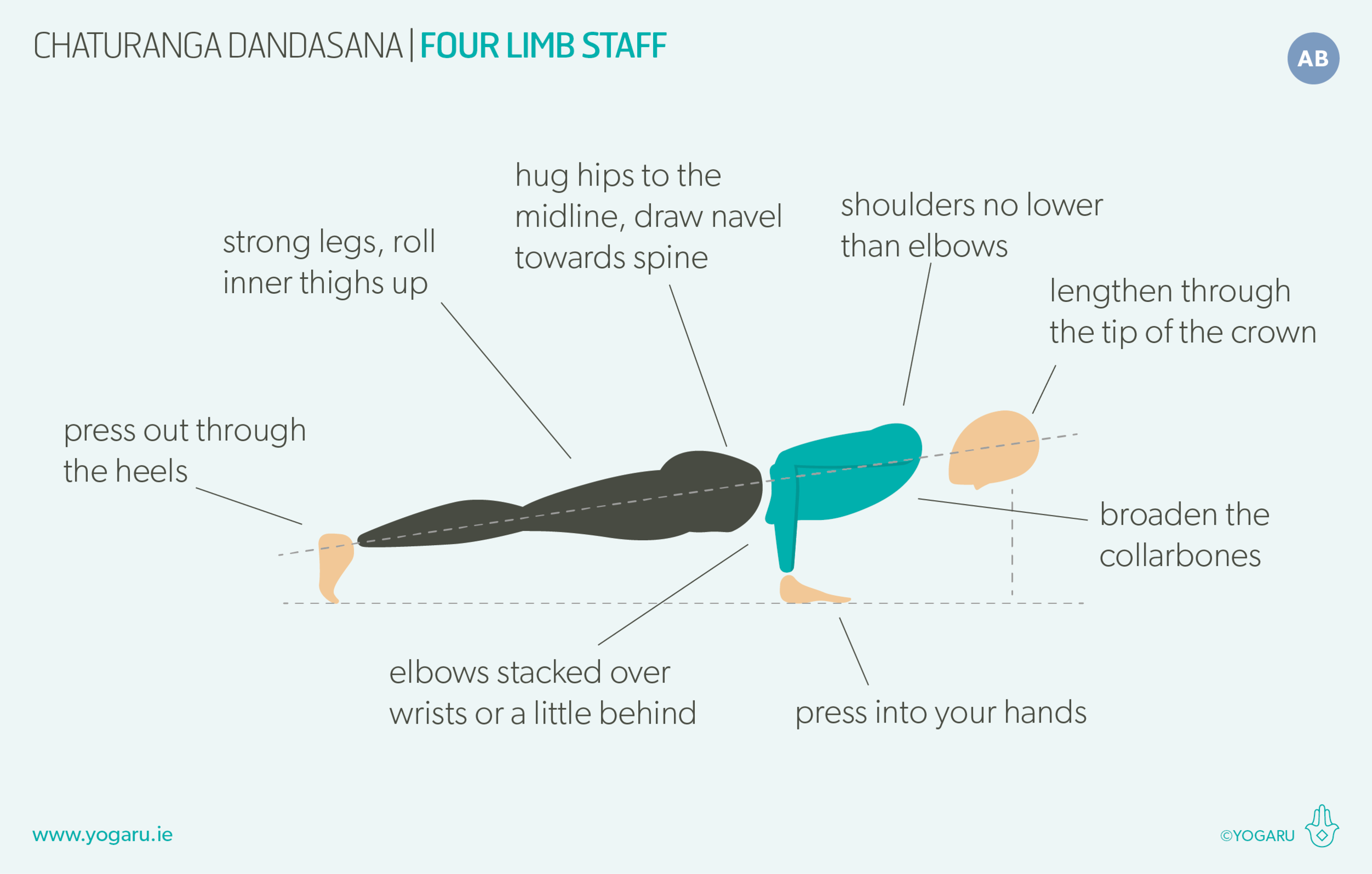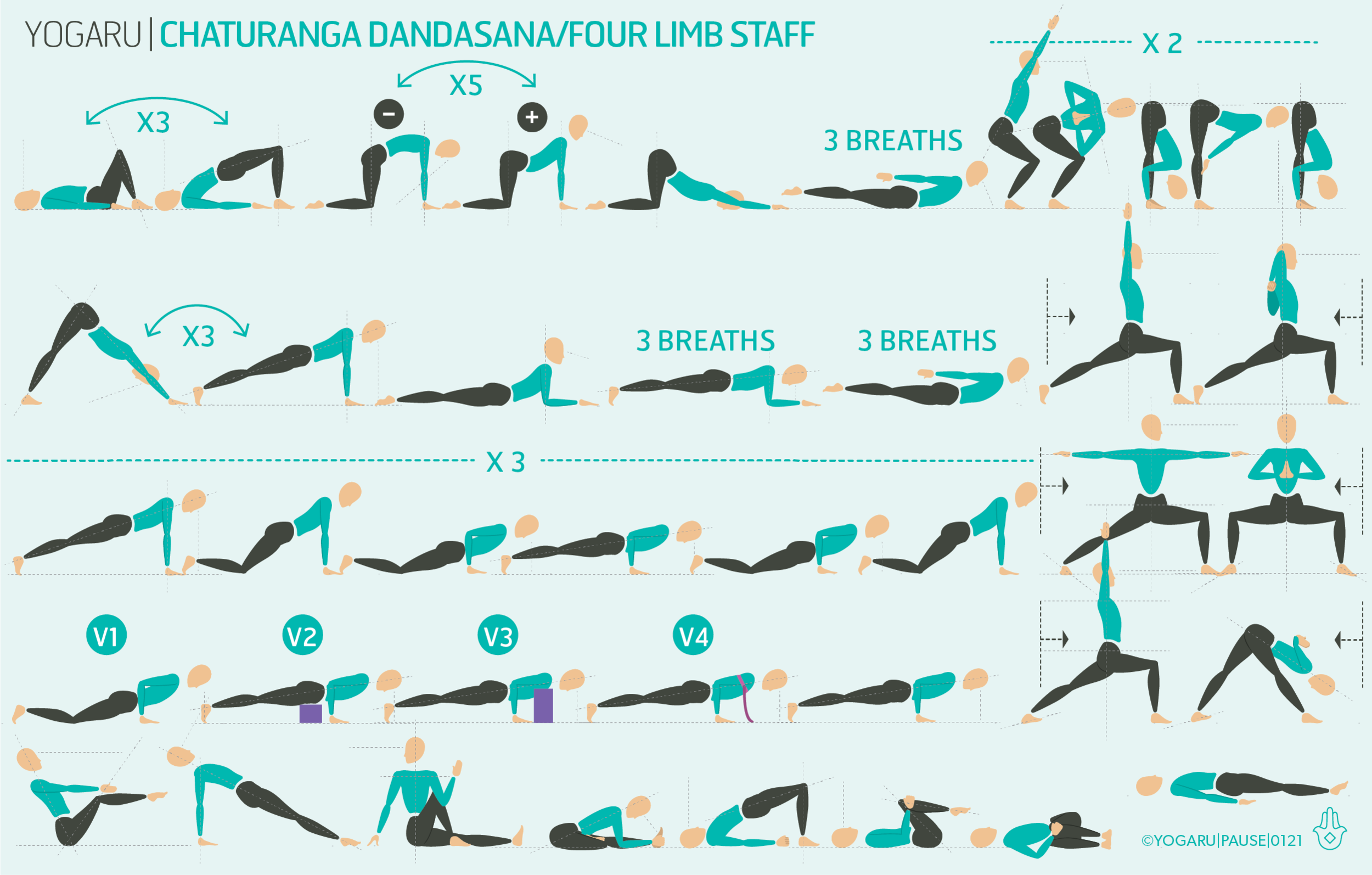NOT JUST A TRANSITIONAL POSE
Chaturanga Dandasana/Four Limb Staff is a pose in its own right which is often lost in vanyasanas somewhere between Phlankasana/Plank and Urdhva Mukha Svanasana/Upwards Facing Dog! It is a tricky pose, which is why we sometimes rush through it to get to Urdhva Mukha Svanasana/Upwards Facing Dog or Bhujangasana/Cobra. When performed repeatedly, and not given the time and respect it deserves, it has the potential to cause shoulder, lower back and wrist injuries. Having a better understanding of the alignment of the pose will not only give you the opportunity to strengthen your arms and shoulders but will help you recognise when to reduce your repetitions of the pose to avoid injuries.
THE BENEFITS OF CHATURANGA DANDASANA/FOUR LIMB STAFF
Chaturanga Dandasana/Four Limb Staff is an arm balancing pose and teaches you the principles of stabilising the shoulder joint and prepares you for more challenging arm balances where the legs are lifted. When performed with integrity it also strengthens the shoulders, spine, arms, core, glutes, and legs.
COMMON MISALIGNMENTS
After several rounds of sun salutations or vinyasas the muscle of the shoulder can start to fatigue. When muscles run out of steam, it can put unwanted load on the joint and potentially injure the fatigued muscles, tendons or the surrounding supporting ligaments. Most of us are asymmetrical – where one side is weaker or stronger than the other – when this is the case it can either put too much pressure on the weaker side, or the stronger side compensates which can eventually increase your chance of repetitive strain injuries. One of the most common misalignments is when the shoulders drop lower than the elbows. When this happens we push great force into the shallow shoulder joint in an extended position. This is not a naturally strong position for the joint, and causes too much reliance on the upper shoulder muscles rather than utilising all of the shoulder muscles. Common misalignments in Chaturanga Dandasana/Four Limb Staff to watch out for are:
Elbows splayed - causes pressure in the shoulder joint - track the elbows with the shoulders.
Shoulders dropped lower than the elbows - causes pressure in the shoulder joint - broaden through the collarbones and lift the chest up to lower down.
Chest sunken down - pinching in between the shoulder blades - press into the hands, spread shoulder blades across your back.
Shoulders hunched up towards ears - neck issues - soften shoulders away from the ears.
Belly dropped down to the ground - pressure in the lower back - draw your navel towards your spine.
EXPLORING CHATURANGA DANDASANA/FOUR LIMB STAFF IN YOUR PRACTICE
This sequence will bring you through different versions of chaturanga to help you build shoulder, spine, arm and core strength to gradually prepare for the peak pose. Some with the knees down to gradually build you up to the full pose, and some using props so you can stay longer in the pose and build a blueprint of it in your body. If the full pose is not safely possible for you at the moment, continue to use the props or bring the knees down for the full sequence. These are valuable versions of the pose and ones I use frequently if I am repeatedly coming down to the floor in my practice. Versions of Chaturanga Dandasana/Four Limb Staff:
V1 - from Phlankasana/Plank Pose bring your knees down and slowly bend your elbows and lower down until your shoulders are no lower than your elbows.
V2 - position a brick under your hips, from Phlankasana/Plank Pose slowly bend your elbow and lower down until your hips are lightly supported by the brick, press into your hands, arms hugging in, collarbones wide, lengthen through the whole spine.
V3 - position two bricks standing upright in front or your fingertips, from Phlankasana/Plank Pose slowly bend your elbow and lower down until your shoulders are lightly supported by the bricks, draw your navel towards your spine, press into your hands, arms hugging in, collarbones wide, lengthen through the whole spine.
V4 - wrap a belt loop around your upper arms, from Phlankasana/Plank Pose slowly bend your elbow and lower down until your chest is lightly supported by the belt, draw your navel towards your spine, press into your hands, arms hugging in, collarbones wide, lengthen through the whole spine.
ALIGNMENT CUES
Take your time with this sequence and treat it like a mini home workshop. If you don’t have bricks use stacked books and if you don't have a belt use a scarf. These versions might take a bit of organisation but it will be well worth the set up time. They support you in the pose and give you a chance to spend a bit of time exploring what your optimum alignment feels like.
Have a read of the tips below and either print out the sequence or save it onto your device:
From Phalakasana/Plank Pose, inhale, press out through your heels to firm your legs, draw your navel towards your spine, firm your shoulder blades onto your back, and broaden through the collarbones.
Press into all five knuckles of your hands pull them towards your feet as you reach your chest forward. Exhale, bend your elbows, track them directly in line with your shoulders.
Lower your chest forward and down. Lift through the upper back and spread your shoulder blades as you lower.
Think ‘up’ as you are coming down.
Hug your hips to the midline and squeeze your thighs. Roll your inner thighs up and reach your tailbone towards your heels.
Draw your navel towards your spine to keep the core strong.
Elbow stacked over wrists or a little further back toward your feet to avoid injury to the wrist or irritation to carpal tunnel syndrome.
Keep your head in line with your spine, back of the neck long, gaze down.
To save the images for personal use click and hold down the image until the ‘save image’ option appears; on Mac hold down ‘control’ and click the image to get the option box; on PC right click on the image to get the option box. Scroll down in the ‘option box’ and click ‘save image’.
Ruth Delahunty Yogaru


